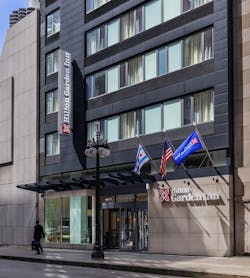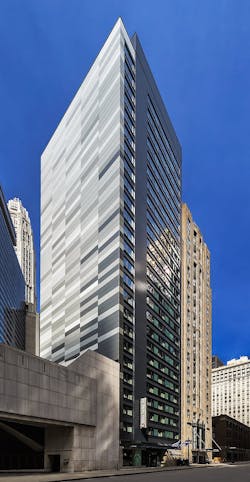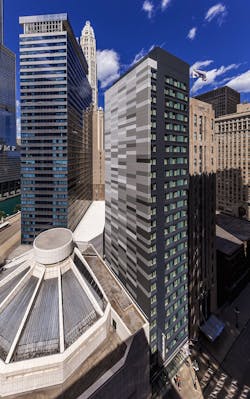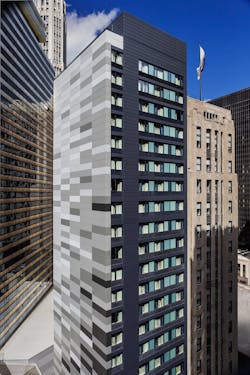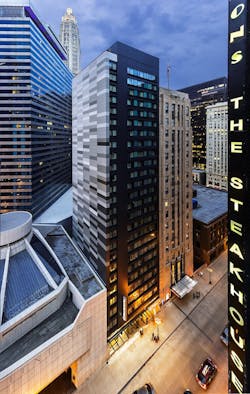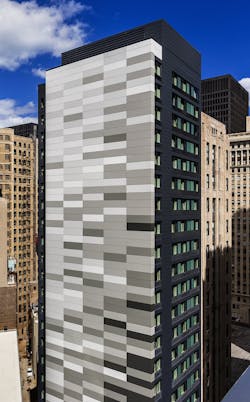Valspar helps diversify new project amongst iconic downtown Chicago buildings
In a city as dense as Chicago, new building projects often have very limited space to make their mark. From its iconic skyline that features the colossal Willis Tower, formerly Sears, to the vast swath of buildings throughout downtown and along the Riverwalk, the “Windy City” presents a difficult, yet exciting playground in which architects and developers can create. For new hotels however, Chicago offers an even stiffer challenge, featuring countless historic accommodations and lodgings that have graced the city for over a century. The new Hilton Garden Inn in the North Loop of downtown Chicago faced these obstacles, and had many additional buildings to compete with, including its landmark neighbors, the Chicago Motor Club and the Seventeenth Church of Christ Scientist. With the desire to standout, GREC Architects were called upon to help make a statement and put the signature stamp of Hilton on Chicago.
Architects David Ervin and Ryan von Drehle knew they would have a very compact build site in which to erect such a prominent structure. The 26-story hotel spanning 96,000 square-feet needed a way to not only differentiate itself among the sea of other hotels and buildings lining the riverfront and downtown area, but also fit into the mix aesthetically. The solution was to incorporate modern design elements into the building that complemented the hotel’s surroundings, including the unmistakable Chicago River.
“We thought about murals and maps, ideas that were more representative, but ultimately the building’s location, as a part of the Chicago River system, became our inspiration, “ said Ervin.
The result is a remarkable piece of artwork that utilizes five shades of complementary grey. The custom 10,000 square-foot exterior metal mosaic façade faces the river, and was created to be an abstract representation of sunlight reflecting on the surface of water. GREC Architects used images of pixelated glints of sunshine, colorful mosaic tiles, and modern art throughout the inspiration and design process to construct the perfect representation.
General contractor Walsh Construction teamed up with G&L Associates, who supplied Formawall Dimension Series CENTRIA metal panels for the exterior. Selected for both their sleek aesthetic appearance and strong performance features, Formawall Dimension Series panels provided the perfect exterior product to make up the Hilton’s façade. Offering maximum thermal performance, superior moisture control, and a bold, embossed exterior, the panels provide an alluring complement to the structure’s overall design scheme.
Coated in five custom grey shades of Valspar’s Fluropon® coatings, Midnight Blue, Stonewall, Sabre Gray, Sleigh Bells and Horizon, the panels provided the team with the necessary medium to achieve their desired aesthetic. The grey hues were chosen because they mixed the designers’ modern inspirations with a classic color palette that will never go out of style. The architects knew they needed the variety of panels to work together and find a coating that would retain the many different individual colors and preserve the integrity of the mosaic for years to come. Fluropon was chosen both for its superior color retention and resistance to chalking when exposed to the different weather elements. These features will help keep the color mosaic of the hotel’s western façade vibrant and protected through the harsh winters and humid summers that frequent the Midwest.
The western exterior serves more than just an aesthetic purpose – because of the narrow build site and existing fire codes, no windows could be placed on the western side of the wall. Additionally, the owner of the property, Magna Hospitality Group, elected not to purchase the air rights above one of the hotel’s neighbors, the Seventeenth Church of Christ Scientist. Consequently, if a new building were to be constructed in its place, the western windows of the hotel would be blocked by new construction. To overcome these issues, the metal panels were constructed as a focal point of the design and most certainly make up for the missing windows with their dynamic appearance. Additionally, this cohesive wall acts as a frame for the existing church and enables a unified experience to be had by those walking the block, as the building fits in seamlessly among the other structures.
This contemporary, multi-colored façade juxtaposes the base of the building, which is made of limestone and aims to reference the historic Chicago Motor Club, another of the hotel’s immediate neighbors. This statement structure was recently converted into a hotel itself, yet remains an art deco gem in the city. GREC Architects again took this into consideration and matched materials to ensure a smooth transition from building to building.
Another seamless transition can be seen on the building itself, as the eye-catching mosaic blends seamlessly with the three other sides of the building. These sides were also composed of Formawall Dimension Series CENTRIA metal panels and coated in Valspar’s Midnight Blue shade of Fluropon, adding flow to the facade. As mentioned earlier, even though the mosaic was designed to stand out, it needed to match aesthetically with the other components of the building and appear as a cohesive part of the structure. The use of the Midnight Blue hue across the entire building allows for unity among the different aspects of the building.
Although great emphasis was placed on its exterior, the interior of the Hilton Garden Inn completes the modern and ambitious design, offering 191 total guestrooms, a business center, bar area, lounges, and more. All meticulously designed by architects to provide a luxurious and comfortable stay for business professionals and families alike, the design was not without its own set of challenges. Without any windows to work with on the hotel’s western front, GREC architects needed to be inventive with the interior room design, in order for each bedroom and suites to feature a flood of natural light. With a fair bit of ingenuity, the western rooms were designed to access light from the north and south sides of the building, in order for the magnificent metal exterior to fully function in tandem with the interior.
The new Hilton Garden Inn officially opened its doors on October 1, 2015, adding to the roster of over 625 Hilton hotels worldwide. With the help of a range of colors, coatings and inventive design, Chicago’s Hilton Garden Inn accomplished its goals of becoming a memorable building in the Chicago skyline, leaving an impression along the riverside and providing a welcoming space for the thousands of guests that will pass through its doors every month.
